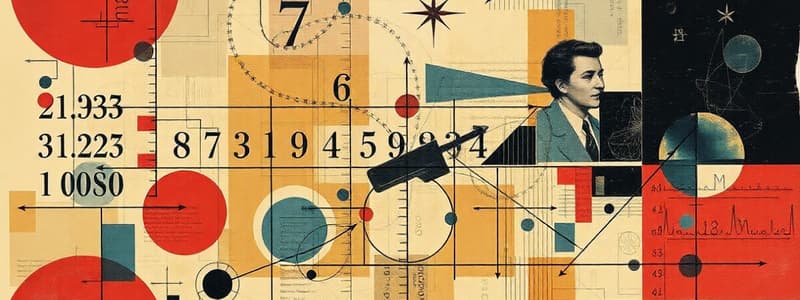Podcast
Questions and Answers
What does the domain of a function represent?
What does the domain of a function represent?
- All possible output values
- The relationship between two variables
- All possible input values (correct)
- The average of the input values
Which term is used to describe the center of a data set?
Which term is used to describe the center of a data set?
- Variance
- Mode (correct)
- Standard deviation
- Outlier
What do Venn diagrams primarily represent?
What do Venn diagrams primarily represent?
- Statistics of a data sample
- Probabilities of events occurring
- Relationships between sets (correct)
- Conversion factors between units
Which of the following is a measure of dispersion?
Which of the following is a measure of dispersion?
What is the main purpose of collecting data in statistics?
What is the main purpose of collecting data in statistics?
What operation involves finding the difference between two numbers?
What operation involves finding the difference between two numbers?
Which of these numbers is an example of a rational number?
Which of these numbers is an example of a rational number?
In an algebraic expression, what do the symbols that represent unknown values called?
In an algebraic expression, what do the symbols that represent unknown values called?
What is the total number of sides in a quadrilateral?
What is the total number of sides in a quadrilateral?
Which theorem states that the square of the hypotenuse is equal to the sum of the squares of the other two sides?
Which theorem states that the square of the hypotenuse is equal to the sum of the squares of the other two sides?
What is the perimeter of a shape?
What is the perimeter of a shape?
Which of the following describes an integer?
Which of the following describes an integer?
What is the defining characteristic of irrational numbers?
What is the defining characteristic of irrational numbers?
Flashcards
Addition
Addition
Combining two or more numbers to find their sum.
Integers
Integers
Whole numbers and their opposites (including zero).
Variables
Variables
Symbols representing unknown values in an equation or expression.
Polynomials
Polynomials
Signup and view all the flashcards
Pythagorean Theorem
Pythagorean Theorem
Signup and view all the flashcards
Rational Numbers
Rational Numbers
Signup and view all the flashcards
Equations
Equations
Signup and view all the flashcards
Perimeter
Perimeter
Signup and view all the flashcards
Conversion Factors
Conversion Factors
Signup and view all the flashcards
Function Domain
Function Domain
Signup and view all the flashcards
Mean
Mean
Signup and view all the flashcards
Set
Set
Signup and view all the flashcards
Logic
Logic
Signup and view all the flashcards
Study Notes
Basic Arithmetic Operations
- Addition involves combining two or more numbers to find their sum.
- Subtraction involves finding the difference between two numbers.
- Multiplication involves repeated addition of a number.
- Division involves distributing a number into equal groups.
Number Systems
- Natural numbers (counting numbers): 1, 2, 3, ...
- Whole numbers: 0, 1, 2, 3, ...
- Integers: ..., -3, -2, -1, 0, 1, 2, 3, ...
- Rational numbers: numbers that can be expressed as a fraction p/q, where p and q are integers and q is not zero.
- Irrational numbers: numbers that cannot be expressed as a fraction of two integers, such as pi (π) and the square root of 2 (√2).
- Real numbers: the set of all rational and irrational numbers.
- Complex numbers: numbers that can be expressed in the form a + bi, where a and b are real numbers and i is the imaginary unit (√-1).
Algebraic Expressions
- Variables: symbols that represent unknown values.
- Constants: fixed values.
- Terms: parts of an expression separated by addition or subtraction signs.
- Coefficients: numerical factors of variables in terms.
- Polynomials: algebraic expressions consisting of variables and coefficients, combined by addition, subtraction, and multiplication.
Equations and Inequalities
- Equations: statements that show the equality of two expressions.
- Solving equations: finding the values of variables that make the equation true.
- Inequalities: statements that show relationships of less than (<), greater than (>), less than or equal to (≤), or greater than or equal to (≥) between two expressions.
- Solving inequalities: finding the values of variables that make the inequality true.
Geometry
- Points, lines, and planes: fundamental building blocks for geometric shapes.
- Angles: formed by two rays sharing a common endpoint.
- Triangles: polygons with three sides and three angles.
- Quadrilaterals: polygons with four sides and four angles.
- Circles: shapes with all points equidistant from a central point.
- Perimeter: the distance around a two-dimensional shape.
- Area: the amount of space enclosed by a two-dimensional shape.
- Volume: the amount of space occupied by a three-dimensional shape.
Basic Geometry Theorems
- Pythagorean Theorem: for a right-angled triangle, the square of the hypotenuse (side opposite the right angle) is equal to the sum of the squares of the other two sides.
Measurement
- Units of measurement: standard units for length, weight, volume, etc.
- Converting units involve using conversion factors to change values from one unit to another.
Functions
- Functions: relationships between input and output values
- Domain: all possible input values.
- Range: all possible output values.
- Graphing functions: visually representing the relationship between inputs and outputs.
Statistics
- Data collection: gathering information about variables or quantities.
- Measures of central tendency: mean, median, and mode; representing the center of a data set.
- Measures of dispersion: standard deviation and variance; showing data spread.
- Probability: the numerical measure of the likelihood of an event occurring.
Sets and Logic
- Sets: collections of objects, which may be finite or infinite.
- Logic: a systematic way to evaluate statements or arguments; using terms like 'and,' 'or,' 'if-then.'
- Venn diagrams: visual representations of relationships between sets.
Studying That Suits You
Use AI to generate personalized quizzes and flashcards to suit your learning preferences.




